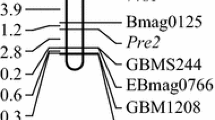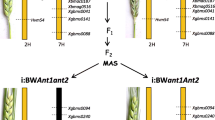Abstract
Purple rice is a type of rice with anthocyanins deposited in its grain pericarp. The rice Pb gene controlling purple pericarp character is known to be on chromosome 4, and the purple color is dominant over white color. In this study, we fine mapped the Pb gene using two F2 segregating populations, i.e. Pei’ai 64S (white) × Yunanheixiannuo (purple) and Pei’ai 64S × Chuanheinuo (purple). In the first-pass mapping, the Pb gene was located in the region downstream the SSR marker RM3820. In the fine mapping, the candidate region was saturated with InDel and CAPS markers developed specifically for this study. Eventually, the Pb gene was mapped within the 25-kb region delimited by the upstream marker RID3 and the downstream marker RID4. The delimited region contained two annotated genes, Ra and bhlh16 (TIGR Rice Genome, R.5). The former is a homologue of the Myc transcription factor Lc controlling anthocyanin biosynthesis in maize, and the latter is a homologue of the TT8 gene, which is also an Myc transcription factor gene controlling the pericarp pigmentation in Arabidopsis thaliana. Sequence analysis showed that the exon 7 of the Ra gene of Yunanheixiannuo and Chuanheinuo had a 2-bp (GT) deletion compared with those of the white rice varieties Pei’ai 64S, 9311 and Nipponbare. A CAPS marker, CAPSRa, was developed according to the GT deletion for analysis of the two F2 segregating populations and 106 rice lines. The results showed that all F2 plants with white pericarp, and all non-purple rice lines (63 white and 22 red) contained no GT deletion, but all 20 purple rice lines contained the GT deletion. These results suggested that the Ra gene may be the Pb gene and the purple pericarp characteristic of rice is caused by the GT deletion within exon 7 of the Ra gene.
Similar content being viewed by others
References
Fossen T, Slimestad R, Ovstedal D O, et al. Anthocyanins of grasses. Biochem Syst Ecol, 2002, 30: 855–864
Abdel-aal E S M, Young J C, Rabalski I. Anthocyanin compositon in black, blue, pink, purple, and red cereal grains. J Agric Food Chem, 2006, 54: 4696–4704
Nagao S, Takahashi M. Genetical studies on rice plants. XXVII. Trial construction of twelve linkage groups in Japanese rice. J Fac Agri Hokkaido Univ, 1963, 53: 72–130
Causse M A, Fulton T M, Cho Y G, et al. Saturated molecular map of the rice genome based on an interspecific backcross population. Genetics, 1994, 138: 1251–1274
Yoshimura A, Ideta O, Iwata N. Linkage map of phenotype and RFLP markers in rice. Plant Mol Biol, 1997, 35: 49–60
Hu J P, Anderson B, Wessler S R. Isolation and characterization of rice R genes: Evidence for distinct evolutionary paths in rice and maize. Genetics, 1996, 142: 1021–1031
Hu J P, Reddy V S, Wessler S R. The rice R gene family: Two distinct subfamilies containing several miniature inverted-repeat transposable elements. Plant Mol Biol, 2000, 42: 667–678
Sakamoto W, Ohmori T, Kageyama K et al. The purple leaf (Pl) locus of rice: Pl w allele has a complex organization and includes two genes encoding basic helix-loop-helix proteins involved in anthocyanin biosynthesis. Plant Cell Physiol, 2001, 42(9): 982–991
Zhuang J Y, Yang C D, Qian H R, et al. Linkage analysis of RFLP markers and the gene for purple pericarp of rice (in chinese). Acta Genetica Sinica, 1996, 23(5): 372–375
Lu Y J, Zheng K L. A convenient method for isolating genomic DNA from rice (in chinese). Chin J Rice Sci, 1992, 6: 47–48
Temnykh S, DeClerck G, Lukashova A, et al. Computational and experimental analysis of microsatellites in rice (Oryza sativa L.): Frequency, length variation, transposon associations, and genetic marker potential. Genome Res, 2001, 11: 1441–1452
Shen Y J, Jiang H, Jin J P, et al. Development of genome-wide DNA polymorphism database for map-based cloning of rice genes. Plant Physiol, 2004, 135: 1198–1205
Nesi N, Debeaujon I, Jond C, et al. The TT8 gene encodes a basic helix-loop-helix domain protein required for expression of DFR and BAN genes in Arabidopsis Siliques. Plant Cell, 2000, 12: 1863–1878
Ludwig S R, Habera L F, Dellaporta S L, et al. Lc, a member of the maize R gene family responsible for tissue-specific anthocyanin production, encodes a protein similar to transcriptional activators and contains the myc-homology region. Proc Natl Acad Sci USA, 1989, 86: 7092–7096
Ji Q, Lu J F, Chao Q et al. Delimiting a rice wide-compatibility gene s5n to a 50 kb region. Theor Appl Genet, 2005, 111: 1495–1503
Chen S H, Wu J, Yang Y et al. The fgr gene responsible for rice fragrance was restricted within 69 kb. Plant Sci, 2006, 171: 505–514
Chen M S, Presting G, Barkazuk W B et al. An integrated physical and genetic map of the rice genome. Plant Cell, 2002, 14: 537–545
Zhao C Z, Qi X F, Yang C D et al. Study of ‘Black superior rice’ selected by the use of somaclonal variation (in chinese). J Agri Biotech, 1993, 1(1): 100–105
Chandler V L, Radicella J P, Robbins T P, et al. Two regulatory genes of maize anthocyanin pathway are homologous: Isolation of B utilizing R genomic sequences. Plant Cell, 1989, 1: 1175–1183
Ludwig S R, Wessler S R. Maize R gene family: Tissue-specific helix-loop-helix protein. Cell, 1990, 62: 849–851
Saitoh K, Onishi K, Mikami I, et al. Allelic diversification at the C (OsC1) locus of wild and cultivated rice: nucleotide changes associated with phenotypes. Genetics, 2004, 168: 997–1007
Baudry A, Caboche M, Lepiniec L. TT8 controls its own expression in a feedback regulation involving TTG1 and homologous MYB and bHLHL factors, allowing a strong and cell-specific accumulation of flavonoids in Arabidopsis thaliana. Plant J, 2006, 46: 768–779
Author information
Authors and Affiliations
Corresponding author
About this article
Cite this article
Wang, C., Shu, Q. Fine mapping and candidate gene analysis of purple pericarp gene Pb in rice (Oryza sativa L.). Chin. Sci. Bull. 52, 3097–3104 (2007). https://doi.org/10.1007/s11434-007-0472-x
Received:
Accepted:
Issue Date:
DOI: https://doi.org/10.1007/s11434-007-0472-x




